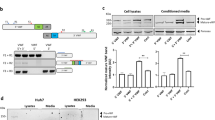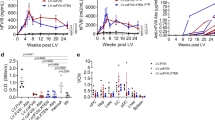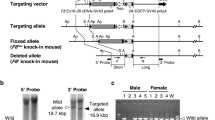Abstract
Replication-deficient lentiviral vectors (LV) have been shown to enable the stable genetic modification of multiple cell types in vivo. We demonstrate here that vascular and hepatic delivery of a third-generation HIV-derived lentiviral vector encoding human Factor IX (LV-hFIX) produced potentially therapeutic serum levels of hFIX protein with no vector-mediated local or systemic toxicity of adult mice. Portal vein administration produced the highest serum levels of hFIX and demonstrated proportionally higher levels of gene transfer to the liver with up to 4% of hepatocytes expressing hFIX. Vascular delivery of a lentiviral vector encoding GFP resulted in genetic modification of up to 12% of liver cells. Cell proliferation was not required for hepatocyte transduction with either vector. Serum hFIX levels reached 4% of normal levels following vascular LV-mediated hFIX gene transfer and remained stable for months following vector administration.
This is a preview of subscription content, access via your institution
Access options
Subscribe to this journal
Receive 12 print issues and online access
$209.00 per year
only $17.42 per issue
Buy this article
- Purchase on Springer Link
- Instant access to full article PDF
Prices may be subject to local taxes which are calculated during checkout





Similar content being viewed by others

References
Dranoff, G. et al. Vaccination with irradiated tumor cells engineered to secrete murine granulocyte-macrophage colony-stimulating factor stimulates potent, specific, and long-lasting anti-tumor immunity. Proc. Natl. Acad. Sci. USA 90, 3539–3543 (1993).
Gansbacher, B. et al. Interleukin 2 gene transfer into tumor cells abrogates tumorigenicity and induces protective immunity. J. Exp. Med. 172, 1217–1224 (1990).
Roberts, M. et al. Targeting of human immunodeficiency virus-infected cells by CD8+ T lymphocytes armed with universal T-cell receptors. Blood 84, 2878–2889 (1994).
McGuinness, R. et al. Anti-tumor activity of human T cells expressing the CC49-zeta chimeric immune receptor. Hum. Gene Ther. 9, 165–173 (1998).
Nguyen, K. et al. Direct synovial gene transfer with retroviral vectors in rat adjuvant arthritis. J. Rheumatol. 25, 1118–1125 (1998).
McCormack, J. et al. Factors affecting long-term expression of a secreted transgene product after intravenous administration of a retroviral vector. Mol. Ther. 3, 516–525 (2001).
Patijn, G., Lieber, A., Schowalter, D., Schwall, R. & Kay, M. Hepatocyte growth factor induces hepatocyte proliferation in vivo and allows for efficient retroviral-mediated gene transfer in mice. Hepatology 28, 707–716 (1998).
Patijn, G., Lieber, A., Meuse, L., Winther, B. & Kay, M. High-efficiency retrovirus-mediated gene transfer into the livers of mice. Hum. Gene Ther. 9, 1449–1456 (1998).
Naldini, L. et al. In vivo gene delivery and stable transduction of nondividing cells by a lentiviral vector. Science 272, 263–267 (1996).
Naldini, L., Blomer, U., Gage, F., Trono, D. & Verma, I. Efficient transfer, integration, and sustained long-term expression of the transgene in adult rat brains injected with a lentiviral vector. Proc. Natl. Acad. Sci. USA 93, 11382–11388 (1996).
Naldini, L. Lentiviruses as gene transfer agents for delivery to non-dividing cells. Curr. Opin. Biotechnol. 9, 457–463 (1998).
Zufferey, R., Nagy, D., Mandel, R., Naldini, L. & Trono, D. Multiply attenuated lentiviral vector achieves efficient gene delivery in vivo. Nat. Biotechnol. 15, 871–875 (1997).
Blomer, U. et al. Highly efficient and sustained gene transfer in adult neurons with a lentivirus vector. J. Virol. 71, 6641–6649 (1997).
Johnston, J. et al. Minimum requirements for efficient transduction of dividing and nondividing cells by feline immunodeficiency virus vectors. J. Virol. 73, 4991–5000 (1999).
Gasmi, M. et al. Requirements for efficient production and transduction of human immunodeficiency virus type 1-based vectors. J. Virol. 73, 1828–1834 (1999).
Park, F., Ohashi, K. & Kay, M. Therapeutic levels of human factor VIII and IX using HIV-1-based lentiviral vectors in mouse liver. Blood 96, 1173–1176 (2000).
Park, F., Ohashi, K., Chiu, W., Naldini, L. & Kay, M. Efficient lentiviral transduction of liver requires cell cycling in vivo. Nat. Genet. 24, 49–52 (2000).
Wion, K., Kelly, D., Summerfield, J., Tuddenham, E. & Lawn, R. Distribution of factor VIII mRNA and antigen in human liver and other tissues. Nature 317, 726–729 (1985).
Pfeifer, A. et al. Transduction of liver cells by lentiviral vectors: analysis in living animals by fluorescence imaging. Mol. Ther. 3, 319–322 (2001).
Ge, Y., Powell, S., Roey, M.V. & McArthur, J. Factors influencing the development of an anti-FIX immune response following administration of AAV-FIX. Blood 97, 3–7 (2001).
Snyder, R. et al. Persistent and therapeutic concentrations of human factor IX in mice after hepatic gene transfer of recombinant AAV vectors. Nat. Genet. 16, 270–276 (1997).
Dull, T. et al. A third-generation lentivirus vector with a conditional packaging system. J. Virol. 72, 8463–8471 (1998).
Zufferey, R. et al. Self-inactivating lentivirus vector for safe and efficient in vivo gene delivery. J. Virol. 72, 9873–9880 (1998).
Zufferey, R., Donello, J., Trono, D. & Hope, T. Woodchuck hepatitis virus posttranscriptional regulatory element enhances expression of transgenes delivered by retroviral vectors. J. Virol. 73, 2886–2892 (1999).
Lipshutz, G. et al. In utero delivery of adeno-associated viral vectors: intraperitoneal gene transfer produces long-term expression. Mol. Ther. 3, 284–292 (2001).
Acknowledgements
We thank Romain Zufferey for his comments and thoughtful discussion.
Author information
Authors and Affiliations
Corresponding author
Rights and permissions
About this article
Cite this article
Tsui, L., Kelly, M., Zayek, N. et al. Production of human clotting Factor IX without toxicity in mice after vascular delivery of a lentiviral vector. Nat Biotechnol 20, 53–57 (2002). https://doi.org/10.1038/nbt0102-53
Revised:
Accepted:
Issue Date:
DOI: https://doi.org/10.1038/nbt0102-53
This article is cited by
-
Gene therapy for hemophilia B mice with scAAV8-LP1-hFIX
Frontiers of Medicine (2016)
-
Role of antigen-specific regulatory CD4+CD25+ T cells in tolerance induction after neonatal IP administration of AAV-hF.IX
Gene Therapy (2013)
-
Hydrogels to modulate lentivirus delivery in vivo from microporous tissue engineering scaffolds
Drug Delivery and Translational Research (2011)
-
Multicistronic lentiviral vectors containing the FMDV 2A cleavage factor demonstrate robust expression of encoded genes at limiting MOI
Virology Journal (2006)
-
Permanent partial phenotypic correction and tolerance in a mouse model of hemophilia B by stem cell gene delivery of human factor IX
Gene Therapy (2006)


